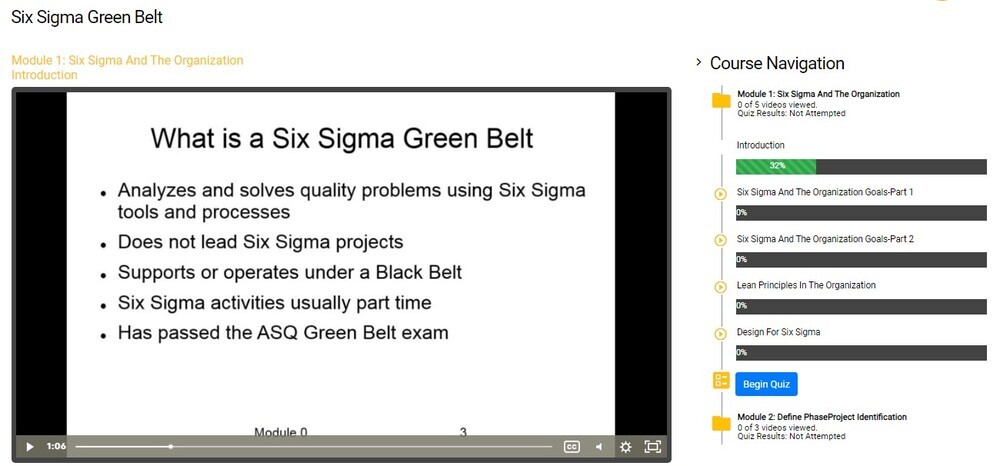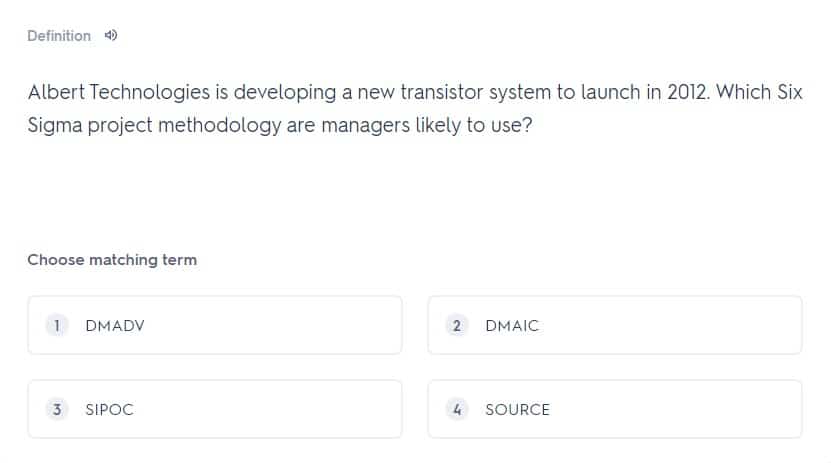Course Description:
Embark on a transformative journey of professional growth with our exhilarating Six Sigma Green Belt training course! Unlock the secrets to unleashing process excellence and become a coveted change agent in your organization. This course is your gateway to mastering the art of process improvement and driving tangible results that will elevate your career to new heights!
Prepare to be captivated by 21 hours of dynamic online training and 55 engaging course videos meticulously designed to ignite your passion for Six Sigma. Through this immersive learning experience, you will delve deep into the core principles and methodologies of Six Sigma, equipping yourself with a powerful arsenal of tools and techniques to revolutionize the way your organization operates.
Gain the expertise to meticulously analyze process components and collaborate seamlessly with Subject Matter Experts and stakeholders. Discover the art of defining project requirements with precision and finesse, ensuring that you deliver nothing short of perfection. Unleash your ability to collect and analyze customer information and feedback, empowering you to meet and exceed their ever-evolving needs.
But that’s not all! As a Lean Six Sigma Green Belt, you will take center stage as a leader and project management virtuoso. Harness your newfound team leadership skills to rally your colleagues towards success, while identifying innovative ways to reduce costs and drive efficiency. With the DMAIC problem-solving methodology as your guiding light, you will navigate complex challenges with ease and confidence, emerging as a beacon of excellence in your organization.
And here’s the cherry on top: upon completion of the course, you will have the opportunity to prove your mastery by acing the Six Sigma Green Belt exam. Achieving this esteemed certification will not only solidify your expertise but also open doors to exciting career advancements and limitless opportunities for professional growth.
So, are you ready to embark on this thrilling adventure of transformation? Join us today and unlock your true potential as a Six Sigma Green Belt. Together, let’s revolutionize processes, exceed customer expectations, and write a success story that will be remembered for years to come!
Levels of Six Sigma and were does the Green Belt fit in?
Grasping the intricacies of the six sigma belt levels may seem daunting, but it doesn’t have to be. Through a color-coded system with several staged processes that must be completed in a hierarchical order, you can obtain your certification and progress through every level up to Master Black Belt. You can start at either Yellow or Green – however, if you wish to move on from there and become a certified Master Black Belt holder afterward then prior completion of an accredited black belt program is necessary first.
Six Sigma White Belt – Acquiring a white belt certification serves as evidence that one has acquired an introductory level of expertise in the basic principles of Six Sigma.
Six Sigma Yellow Belt – A Yellow Belt certification indicates that you have learned the specifics of how Six Sigma works, how its disciplines are applied to the workplace, and where best to concentrate your time as you learn the process.
Six Sigma Green Belt – This course is perfect for both beginners and intermediates looking to utilize Lean Six Sigma tools within project teams. Not only will Green Belt receive in-depth, comprehensive training on how to gather project requirements and apply relevant concepts, but those who complete it successfully can also earn Green Belt certification that demonstrates their ability in carrying out advanced analysis and resolve quality improvement projects. What’s more, successful Green Belt candidates will be well-equipped with the skills necessary to lead and manage projects while providing essential support to Six Sigma Black Belts.
Six Sigma Black Belt – Becoming a Black Belt indicates your expertise in the Six Sigma philosophy and principles. As such, you become an influential driving force of change within any organization while leading project teams to success. If you are determined to achieve the rank of Black Belt, look no further than our Black Belt Six Sigma online program.
Course Outline:
Module 1: Six Sigma And The Organization
Introduction
Six Sigma And The Organization Goals-Part 1
Six Sigma And The Organization Goals-Part 2
Lean Principles In The Organization
Design For Six Sigma
Module 2: Define PhaseÂProject Identification
Define Phase-Project Identification-Part 1
Define Phase-Project Identification-Part 2
Define Phase-Project Identification-Part 3
Module 3: Define PhaseÂVoice Of The Customer
Define Phase-Voice Of The Customer-Part 1
Define Phase-Voice Of The Customer-Part 2
Module 4: Define Phase Project Management Basics on Six Sigma Green Belt
Define Phase-Project Management Basics-Part 1
Define Phase-Project Management Basics-Part 2
Module 5: Define PhaseÂManagement And Planning Tools
Define Phase-Management And Planning Tools Part 1
Define Phase-Management And Planning Tools-Part 2
Module 6: Define PhaseÂBusiness Results For Projects
Define Phase-Business Results For Projects-Part 1
Define Phase-Business Results For Projects-Part 2
Module 7: Define PhaseÂTeam Dynamics And Define Phase Summary Review
Questions
Define Phase-Team Dynamics And Review Questions
Define Phase-Summary And Review Questions
Module 8: Measure PhaseÂProcess Analysis And Documentation
Measure Phase-Process Analysis And Documentation
Module 9: Measure PhaseÂProbability And Statistics
Measure Phase-Probability And Statistics
Module 10: Measure PhaseÂStatistical Distributions
Measure Phase-Statistical Distributions
Module 11: Measure PhaseÂCollecting And Summarizing Data
Measure Phase-Collecting And Summarizing Data-Part 1
Measure Phase-Collecting And Summarizing Data-Part 2
Module 12: Measure PhaseÂMeasurements System Analysis (MSA)
Measure Phase-Measurements System Analysis(MSA)
Module 13: Measure PhaseÂProcess And Performance Capability And Measure
Phase Summary And Review
Measure Phase-Process And Performance Capability And Measure Phase Summary And Review
Module 14: Analyze PhaseÂExploratory Data Analysis And Hypothesis Testing
Analyze Phase-Exploratory Data Analysis And Hypothesis Testing-Part1
Analyze Phase-Exploratory Data Analysis And Hypothesis Testing-Part2
Analyze Phase-Exploratory Data Analysis And Hypothesis Testing-Part3
Module 15: Analyze Phase  Process Drivers
Analyze Phase-Process Drivers-Part 1
Analyze Phase-Process Drivers-Part 2
Analyze Phase-Process Drivers-Part 3
Analyze Phase-Process Drivers-Part 4
Analyze Phase-Process Drivers-Part 5
Module 16: Improve PhaseÂDesign Of Experiment (DOE)
Improve Phase-Design Of Experiment(DOE)-Part 1
Improve Phase-Design Of Experiment(DOE)-Part 2
Module 17: Improve PhaseÂRoot Cause Analysis
Improve Phase-Root Cause Analysis-Part 1
Improve Phase-Root Cause Analysis-Part 2
Improve Phase-Root Cause Analysis-Demo
Module 18: Improve PhaseÂLean Tools
Improve Phase-Lean Tools-Part 1
Improve Phase-Lean Tools-Part 2
Improve Phase-Lean Tools-Part 3
Improve Phase-Lean Tools-Part 4
Module 19: Control Phase Statistical Process Control
Control Phase-Statistical Process Control
Module 20: Control PhaseÂLean Tools For Process Control
Control Phase-Lean Tools For Process Control-Part 1
Control Phase-Lean Tools For Process Control-Part 2
Control Phase-Lean Tools For Process Control-Part 3
Module 21: Review ExamÂPrep And Key Concepts
Exam Review And Key Concepts-Part 1
Exam Review And Key Concepts-Part 2
Exam Review And Key Concepts-Part 3
Exam Review And Key Concepts-Part 4
Exam Review And Key Concepts-Part 5
Exam Review And Key Concepts-Part 6
Exam Review And Key Concepts-Part 7
Exam Review-Flash Cards







